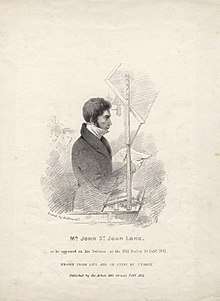John St. John Long
John St. John Long (1798–July 2, 1834)[1] was an Irish-born quack doctor who claimed to be able to cure tuberculosis. In two instances he was tried for manslaughter of his patients. In the first case he was found guilty and fined £250, and in the second case acquitted. He died at the age of 35, reportedly from tuberculosis[1][2] but perhaps merely from a horse-riding accident.[2]

Life
_dressed_as_Wellcome_V0016227.jpg)
Long, born in Newcastle West in 1798, was the second son of John Long, basket-maker and jack-of-all-trades, by Anne St. John. He showed some gift for drawing and in 1816 some charitable local people contributed money for him to attend the Royal Dublin Society's school of design. He returned to Limerick two years later and supported himself by giving drawing lessons. In 1822 he came to London, and in 1827 began his quack medical practice which was so successful that he was shortly able to move to Harley Street.[1]
Long's treatments for tuberculosis both involved secret formulas, one inhaled, the other rubbed on the back or chest.[2] The rubbing treatment was conducted daily for five to ten days until the patients developed a running sore, which Long said allowed the disease to leave the body.[2][4]
Trials

In 1830 Long was tried for the death of his patient Mrs. Catherine Cashin, age 24. Cashin's mother had visited Long to consult about her younger daughter Ellen, who was sixteen and did have tuberculosis. Preying on the mother's fears, Long convinced her to obtain treatment for Catherine as well, although Catherine appeared to be in perfect health.[4] The wound he caused her became severely infected, and Catherine began constantly vomiting. Long prescribed mulled wine, which Catherine was unable to keep down. A Doctor Brodie was called in, over Long's objections, but Cashin died the following day.[4]
Long was tried at the Old Bailey. He argued he was not responsible and that the death was caused by Dr. Brodie's intervention and produced favorable testimony from his other patients. Nevertheless, he was found guilty of manslaughter on 23 October 1830, but was sentenced only to a fine of £250,[1] which he paid immediately.[4]
The following month Long was indicted for the manslaughter of Mrs. Colin Campbell Loyd, but was acquitted on 18 November.
Death
Long is said to have died of tuberculosis himself,[1][2] and refused treatment by his own method,[1] on 2 July 1834. Some of his former patients contributed to erect a monument to him at his tomb in Kensal Green Cemetery, with a complimentary inscription.[4] He left his property, including his secret remedy (which he valued at £10,000) to his brother William.
Publications
- Discoveries in the Science and Art of Healing, London, 1830; 2nd edition 1831.
- A Critical Exposure of the Ignorance and Malpractice of certain Medical Practitioners in their Theory and Treatment of Disease, London, 1831.
Notes
References
- Rigg, James McMullen (1893). . In Lee, Sidney (ed.). Dictionary of National Biography. 34. London: Smith, Elder & Co.CS1 maint: ref=harv (link)
- Hempel, Sandra (3 May 2014). "John St John Long: quackery and manslaughter". The Lancet. 383 (9928): 1540–1541. doi:10.1016/S0140-6736(14)60737-6. PMID 24800298.
- Rayner, J.L.; Crook, G.T., eds. (1926). The Complete Newgate Calendar. 3. Navarre Society.
![]()
External links
![]()